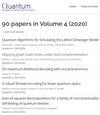The resource theory of tensor networks
IF 5.1
2区 物理与天体物理
Q1 PHYSICS, MULTIDISCIPLINARY
引用次数: 0
Abstract
Tensor networks provide succinct representations of quantum many-body states and are an important computational tool for strongly correlated quantum systems. Their expressive and computational power is characterized by an underlying entanglement structure, on a lattice or more generally a (hyper)graph, with virtual entangled pairs or multipartite entangled states associated to (hyper)edges. Changing this underlying entanglement structure into another can lead to both theoretical and computational benefits. We study a natural resource theory which generalizes the notion of bond dimension to entanglement structures using multipartite entanglement. It is a direct extension of resource theories of tensors studied in the context of multipartite entanglement and algebraic complexity theory, allowing for the application of the sophisticated methods developed in these fields to tensor networks. The resource theory of tensor networks concerns both the local entanglement structure of a quantum many-body state and the (algebraic) complexity of tensor network contractions using this entanglement structure. We show that there are transformations between entanglement structures which go beyond edge-by-edge conversions, highlighting efficiency gains of our resource theory that mirror those obtained in the search for better matrix multiplication algorithms. We also provide obstructions to the existence of such transformations by extending a variety of methods originally developed in algebraic complexity theory for obtaining complexity lower bounds. The resource theory of tensor networks allows to compare different entanglement structures and should lead to more efficient tensor network representations and contraction algorithms.求助全文
约1分钟内获得全文
求助全文
来源期刊

Quantum
Physics and Astronomy-Physics and Astronomy (miscellaneous)
CiteScore
9.20
自引率
10.90%
发文量
241
审稿时长
16 weeks
期刊介绍:
Quantum is an open-access peer-reviewed journal for quantum science and related fields. Quantum is non-profit and community-run: an effort by researchers and for researchers to make science more open and publishing more transparent and efficient.
 求助内容:
求助内容: 应助结果提醒方式:
应助结果提醒方式:


